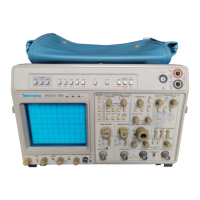Controls, Connectors,
and
Indicators
5-22
NOISE REJ
HF
REJ
LF REJ
AC
All frequency components
of
the input signal are
coupled
to
the trigger. This coupling improves trigger
stability with signals accompanied by low-level noise.
Attenuates high-frequency triggering-signal
components above
50 kHz. This coupling eliminates
radio-frequency interference and high-frequency
noise components from the signal
applied to the
trigger.
It allows triggering on the low-frequency
components of a complex waveform.
Signals are capacitively coupled, blocking the dc
component
of
the triggering signal and attenuating
the low-frequency signal components below
50 kHz.
This coupling allows triggering on the high-frequency
components of a complex waveform.
Signals are capacitively coupled. Frequency
components below
60 Hz are attenuated, and the dc
component
of
the input signal is blocked. This
coupling works for signals that are superimposed on
slowly changing dc voltages. This method will work
for
most signals when trigger-level readout is not
desired.
Only with the available TV enhancement, the trigger Coupling buttons and
indicators select four additional trigger couplings. The readout shows which
of
these couplings and which line number are selected, in the upper right
corner of the
CRT.
If
that corner is occupied, the TVinformation
is
displayed
in the upper left corner.
LINES
FLD 1
FLD 2
The A Sweep triggers
at
TV horizontal line-sync
pulses.
AUTO trigger mode
is
automatically selected.
The A Sweep triggers on a selected
line in the first
field
of
a TV signal. NORM trigger mode
is
automatically selected.
The A Sweep triggers on a selected
line in the
second field of a TV
Signal. NORM trigger mode is
automatically selected.
2465A/2455A/2445A Operators

